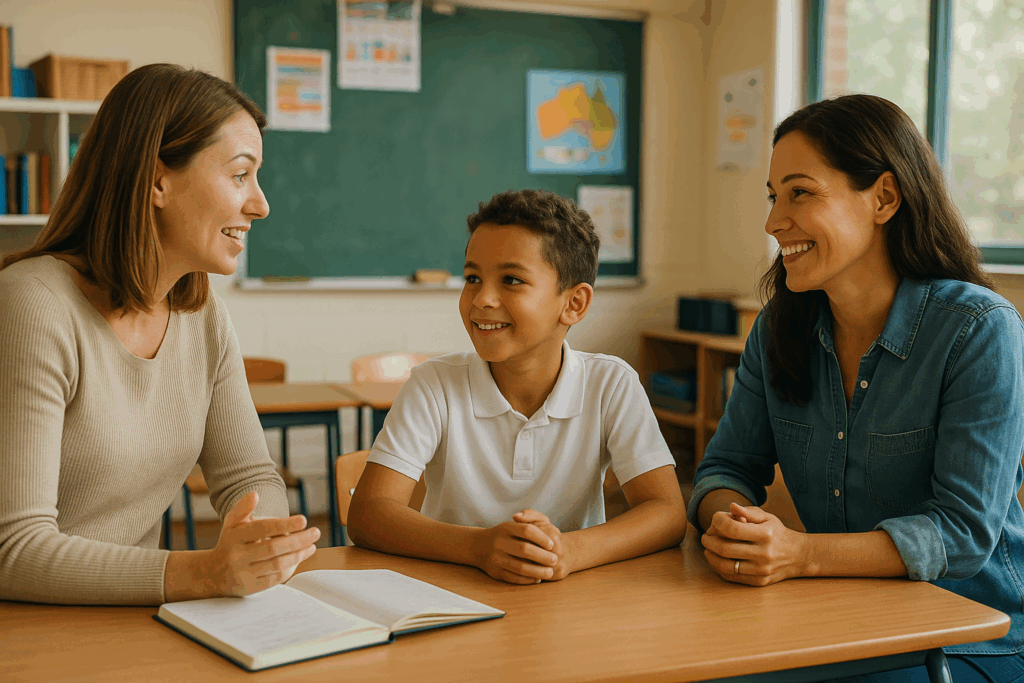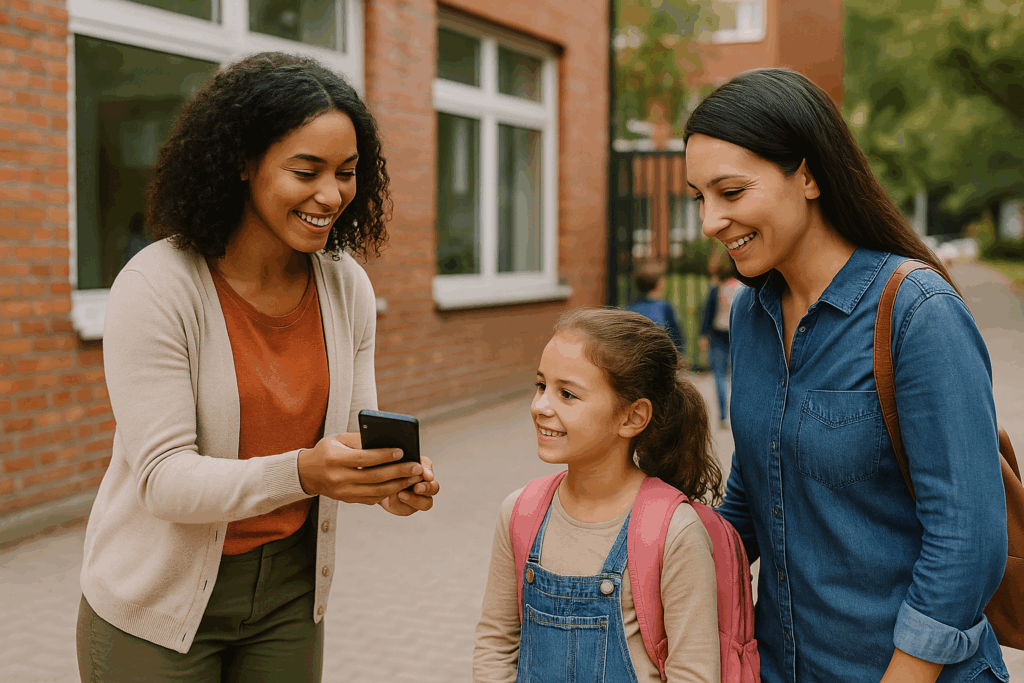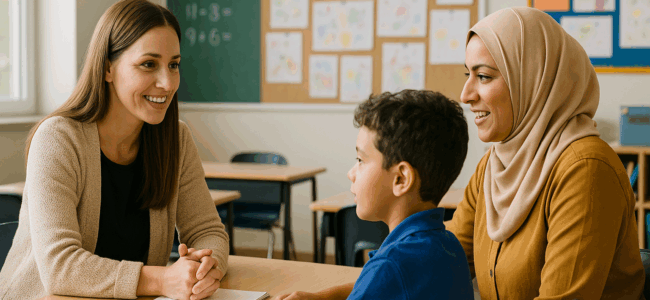Thousands of teachers across Australia manage parent relationships daily, yet your teaching skills won’t make the impact they should if families don’t trust you. When parents feel disconnected from their child’s education, everyone loses. Hence, the need for strong parent-teacher communication!
The thing is, effective parent-teacher communication creates collaborative partnerships with families. These connections prove you truly care about each child’s progress.
In this guide, we’ll walk you through practical strategies that work for real teachers. You’ll learn why parent-teacher communication helps students do better. Moreover, you’ll find simple techniques you can start using right away to build stronger relationships with families.
Read on to learn more about creating positive parent relationships that strengthen your classroom impact.
Why Parent-Teacher Communication Drives Australian Children’s Education Success
Parent-teacher communication boosts Australian children’s education success because it connects two of the most important parts of a child’s world. When home and school work together, students get the consistent support they need to learn and grow.

Let’s look at the real benefits if parents and teachers team up:
- Academic Performance: When home and school work well, students do better in class. This happens because parents can help with homework and learning goals as soon as they know what teachers are covering in class.
- Behaviour Management: Here’s something cool about classroom problems. The reality is, these issues go down as children feel safe. The feeling of security comes from knowing that important adults communicate with each other. Beyond creating safety, this communication helps teachers understand student behaviour better when parents share what happens at home.
- Long-term Success: Over time, strong partnerships help students feel confident through high school and after. Because of ongoing support, students see that their education is important to everyone around them, and that connection inspires them to keep learning.
Time to learn the steps for building lasting parent-teacher bonds.
Building Teacher-Parent Relationships That Work
Building teacher-parent relationships doesn’t have to feel like solving a puzzle. Many teachers worry about that first conversation or wonder if parents will judge their teaching methods.
The truth is: strong parent-teacher communication begins with understanding what both sides really want.
Here’s a simple framework that works even with the trickiest families:
- The Trust Builder: Start with something positive. Put simply, contact parents with good news before discussing problems, and you’ll build trust from day one.
- Find Their Frequency: What communication style works best for you? The answer varies because some parents want daily updates, while others prefer weekly summaries. For this reason, find out their preference early so messages truly get read and appreciated.
- Share Your Goals Step: Parents engage more when they understand your teaching goals. So, share what you’re trying to achieve with their child. This creates a partnership instead of confusion about your teaching methods.
- Easy Connection Methods: You must adapt to how parents communicate best. To do this effectively, use methods they prefer like text messages, emails, and quick chats at pickup. And most importantly, remove barriers that stop communication from happening in the first place.
Once parents follow these steps, they feel more connected to their child’s learning progress.
Useful Strategies for Education and Care Settings
Forget everything you know about formal parent-teacher conferences. We have seen that the most powerful conversations happen in hallways, at school gates, and through quick messages that take less than a minute to send.

The following two practical approaches have enhanced how successful teachers engage with families.
Quick Check-ins for Busy Teachers
Daily communication doesn’t mean lengthy emails. Instead, a quick “Emma helped a classmate today” text takes 30 seconds but builds trust for weeks. And parents appreciate knowing their child’s day included something positive.
Try this 2-minute rule: you can share good news in under two minutes, do it immediately. These brief connections prevent small issues from becoming big problems later.
Technology Tools Parents Will Regularly Use
Class apps might sound great in theory, but most parents move on from them after the first week. Rather than introducing new apps, focus on communication methods families already have on their phones.
For example, use text messages for quick notes, emails for longer discussions, and phone calls for anything urgent. That way, you’re using methods they’re comfortable with, and they’ll be more likely to reply.
These strategies work even better when you extend the partnership beyond the classroom walls.
Supporting Learning at Home Through Better Collaboration
Support at home works best when parents know what’s happening at school. Yet many families struggle to help their children because they don’t understand current teaching approaches or weekly goals.
The solution is clear communication between home and school. You can share short explanations of what students are studying each week so parents feel informed and involved.
Then give families simple activities that connect to those lessons. For example, if students are learning about measurement, suggest parents measure ingredients while cooking together, or if the class is studying local history, recommend visiting a nearby historical site on weekends.
These small tasks help parents reinforce what happens in class without confusion.
As parents gain clarity about your teaching methods, support at home grows stronger. The result is fewer homework battles and greater confidence for students.
Overcoming Common Communication Challenges
Every teacher has met challenging parents who seem difficult to communicate with effectively. The reality is that communication problems often stem from misunderstandings rather than a lack of care about their child’s education.

Most barriers disappear whenever you identify the real issues behind poor parent-teacher communication.
- Silent Parents Often Feel Overwhelmed: They might worry about saying the wrong thing or feel intimidated in a school setting. So start with short, positive messages to build their confidence gradually.
- Different Cultural Backgrounds Create Confusion: Some families hesitate to contact teachers directly due to cultural norms. You can help by acknowledging these differences and explaining that parent input helps their child succeed. For more practical strategies, visit the Teacher Guide to Parent-Teacher Communication from the NSW Department of Education.
- Busy Schedules Make Communication Hard: Single parents or shift workers can’t always respond quickly. This is why you should offer multiple contact options and flexible timing for important conversations.
The sooner these barriers are managed, the faster the partnerships will develop.
Starting Strong Parent Communication Today
Parent-teacher communication problems happen to thousands of Australian teachers every day. Many teachers find it hard to build good relationships with families while running busy classrooms. But simple strategies can change these talks into strong partnerships that help everyone.
This guide shows ways to build relationships, practical communication ideas for schools, home teamwork methods, and fixes for common problems. Each way helps create real connections that help students do better through clear messages.
Francis Orr connects schools with teachers who are great at family partnerships. Contact us today to find teachers who care about strong parent communication and great teaching!

